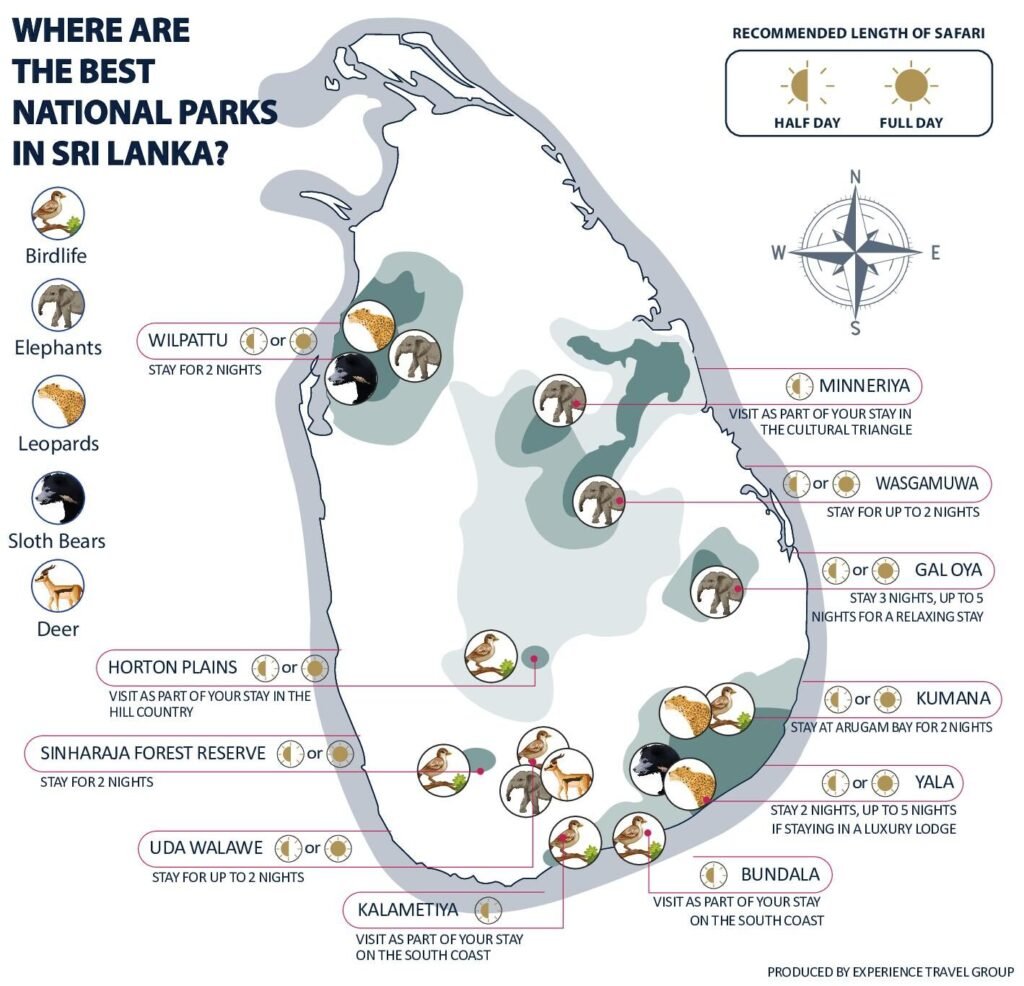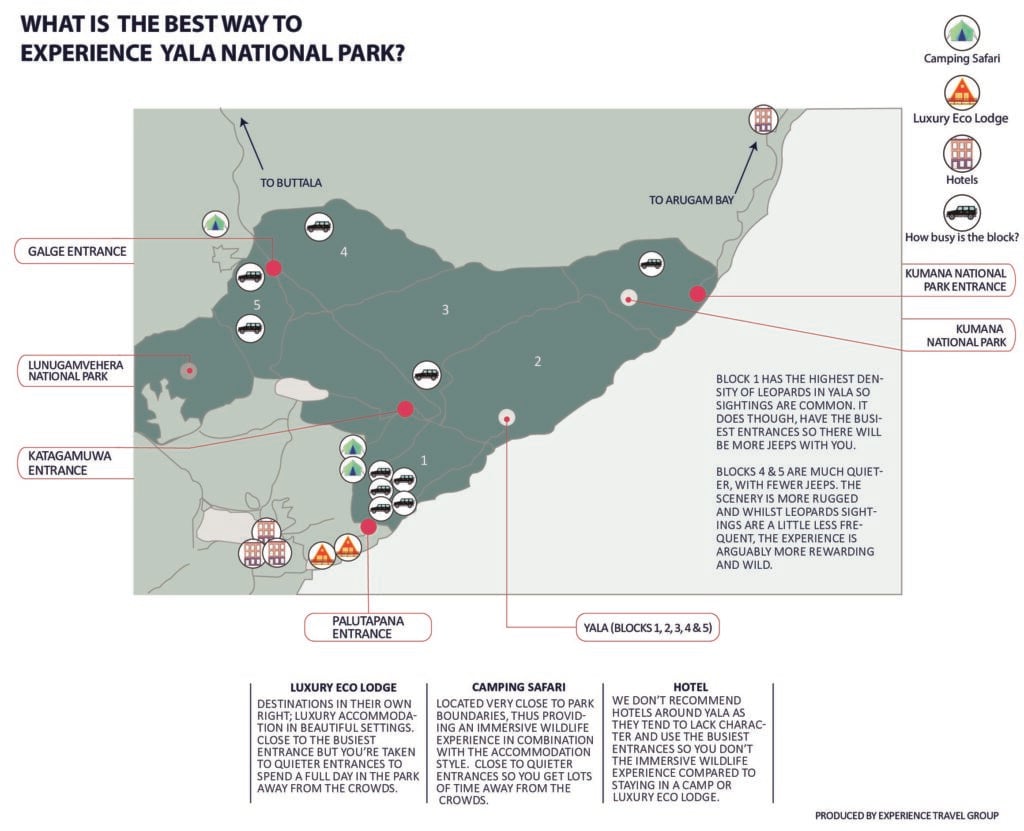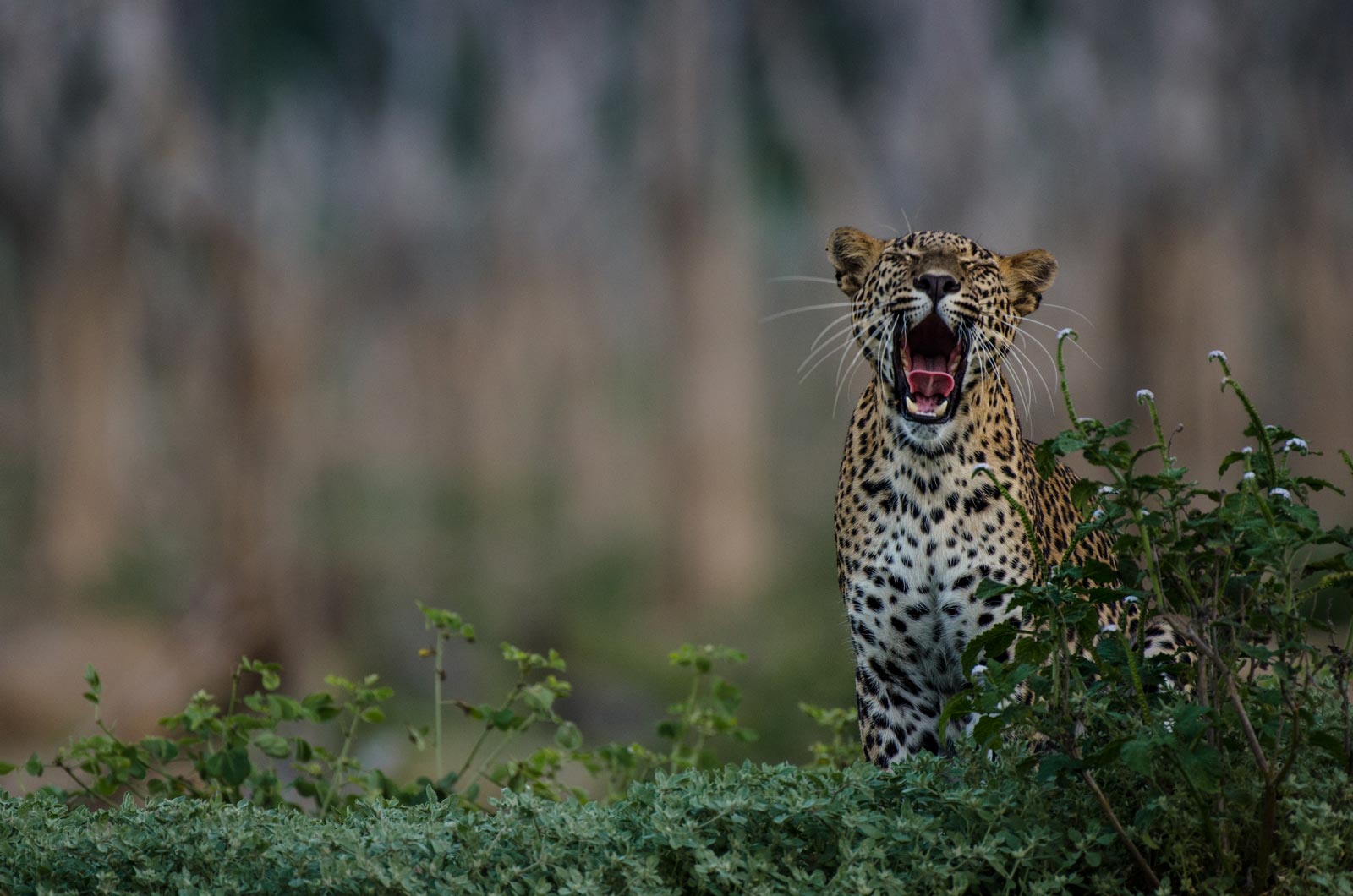
There are 26 National Parks in Sri Lanka, making it one of the best places to see wildlife in Asia. Each park offers a fantastic opportunity to see the flora and fauna of Sri Lanka, but every location and wildlife experience is different. This makes it crucial to work out which type of encounter you’re after – do you prioritise big mammals, birds, comfort, or simplicity? The island has it all; you just need to know where to find it and what the best wildlife experiences in Sri Lanka are for you.
We hope this can act as your ultimate guide to wildlife in Sri Lanka. We’ll cover which amazing species make the island their home, where you can see different types of animals, the various accommodation you can stay in, and how you can fit these experiences into a Sri Lanka holiday.
It’s important to remember, however, that the best wildlife experiences can’t be forced. You might be lucky enough to spot a leopard in a national park. Equally, you might find your most memorable encounter is completely spontaneous – a rare bird flying past your hotel window, or a flock of fruit bats in the middle of a city. Our job is to create the conditions, and give you all the right information, to make wonderful wildlife encounters possible – the rest is up to nature’s whim.
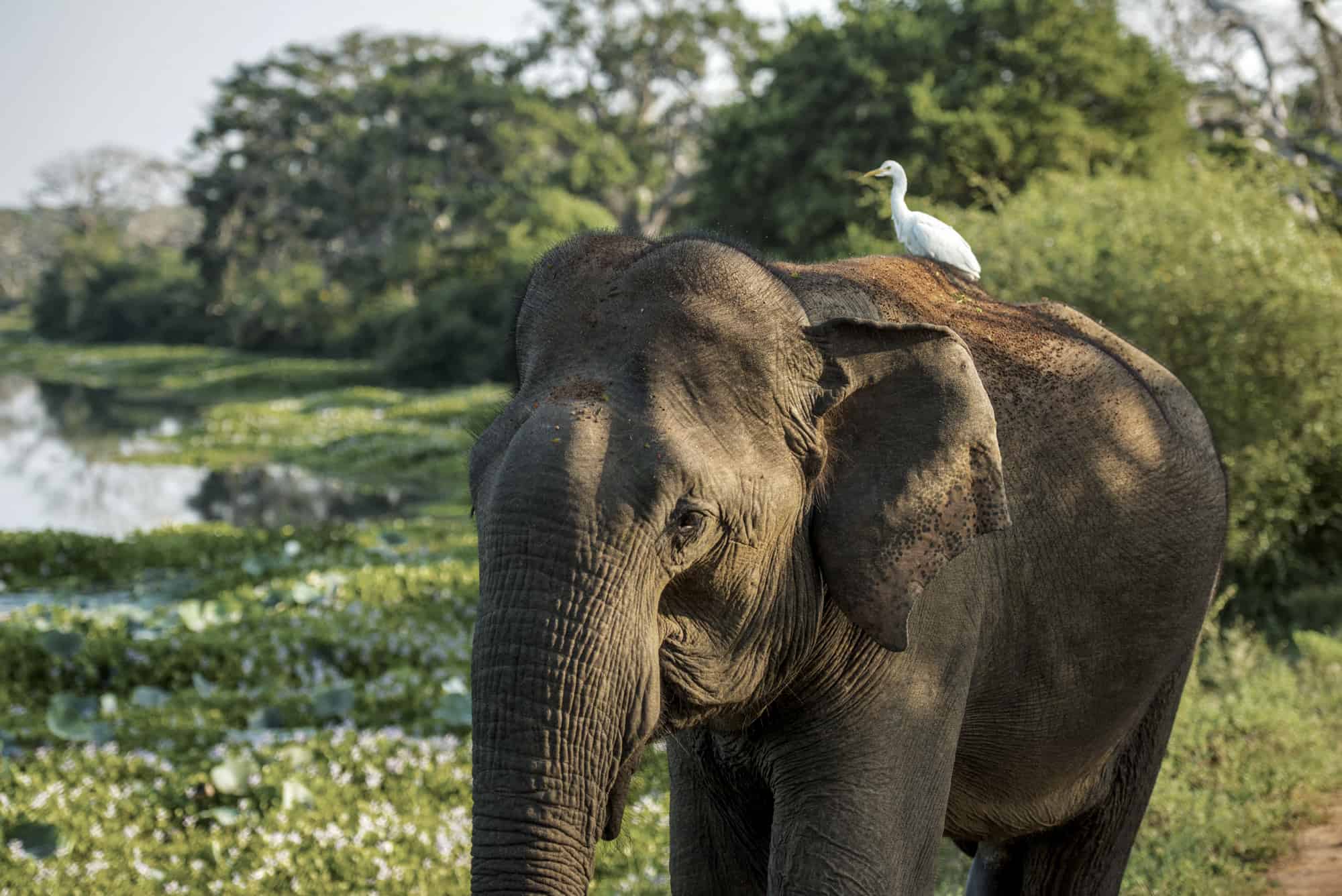
When is the best time to visit Sri Lanka for wildlife?
All year round, Sri Lanka is a fantastic destination for wildlife. Sri Lanka has two monsoon seasons, each affecting the East and West sides of the country at different times of the year. This means that there are always dry areas offering great safaris whenever you choose to visit.
In general, the best time to visit the Southern parks is from December-August. They are particularly brilliant between December-April due to leopards’ mating season and migratory birds. The Northern parks are typically best in between May-August and January-April.
Birdlife is fantastic year-round, but particularly spectacular from November-March when migratory species roost and nest.
Whale watching season is from December-March. You can spot them from Mirissa on Sri Lanka’s South Coast. However, do be careful: many companies offer whale-watching experiences, and they’re not always ethical – always check with a specialist to verify the standards of your supplier (it’s not just good for the whales – booking with a reputable company guarantees a better experience for you, too). You can read an account of a great whale watching experience and one about a not-so-great whale watching experience!
What wildlife is there to see in Sri Lanka?
Sri Lanka’s wildlife offering is incredibly diverse, including but not limited to:
- Leopards
- Other wild cats – the Fishing Cat (Prionailurus viverrinus), the Jungle Cat (Felis chaus), and the Rusty-spotted Cat (Prionailurus rubiginous)
- Asian elephants
- Crocodiles
- Turtles
- The grey langur
- The golden palm civet
- Sri Lankan Junglefowl (Sri Lanka’s national bird!)
- Blue whales
- A huge variety of exotic birds (eg Sri Lanka blue magpie, Serendib Scops Owl, Old World Babbler, Sri Lanka grey hornbill, Yellow-eared bulbul, and more…)
- Sloth bears
- Sambar deer
- Red slender lorises’
Whilst you can see various different wildlife in most parks, certain parks are particularly good for one ‘main’ animal. So, we may suggest different locations depending on which wildlife most intrigues you.
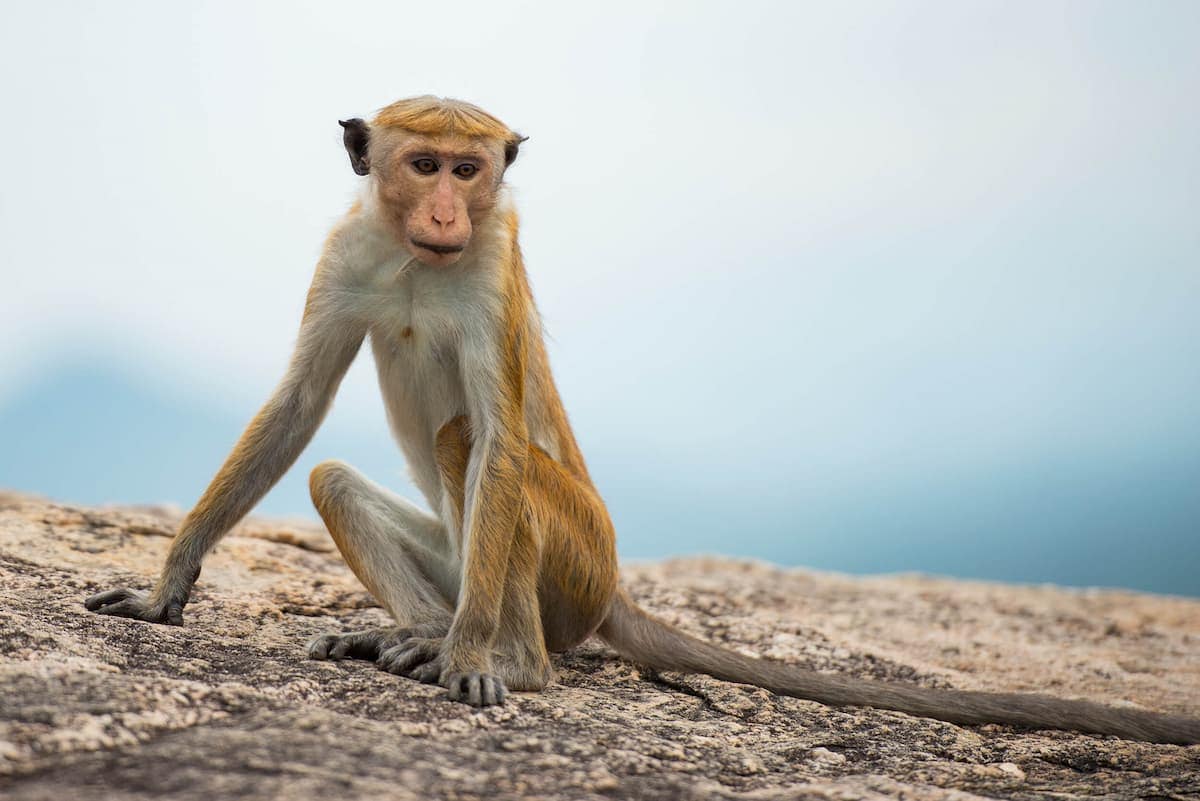
Where is the best national park to spot leopards in Sri Lanka?
- Yala National Park offers Sri Lanka’s most well-known wildlife safari, famous for its high density of leopards, possibly the highest in the world. In Yala, your chances of seeing the elusive leopard are generally very good. The leopards here are accustomed to jeeps and people, so they are more relaxed and usually easier to spot than in other parks. Yala is situated in the Southeast corner of Sri Lanka and can easily slot into most holidays – we find it often works best towards the end of a trip in combination with a south coast beach stay.
- Kumana National Park, sometimes known as Yala East, lies on Sri Lanka’s Southeast coast, just 20m south of the surf destination Arugam Bay. With thicker forest, rocky outcrops, and shyer animals, it can be a bit trickier to spot leopards here, but when you do it is exceptionally rewarding. It is a stunning park that includes impressive overgrown temples – tomb raider style! – that add to such a wild experience.
- Wilpattu is the largest national park in Sri Lanka and one of the oldest protected areas in the country. Wilpattu is excellent for leopard spotting in the dry season (January-April) as this is also mating season. The previous year’s cubs will be about a year old and at a very playful and exploratory age. The best time for spotting leopards in Wilpattu is usually in August-September, just before the Northeast monsoon arrives, as leopards are forced out of their forest hiding places in search of water at the many ‘villus’ or lakes that are scattered around the park.
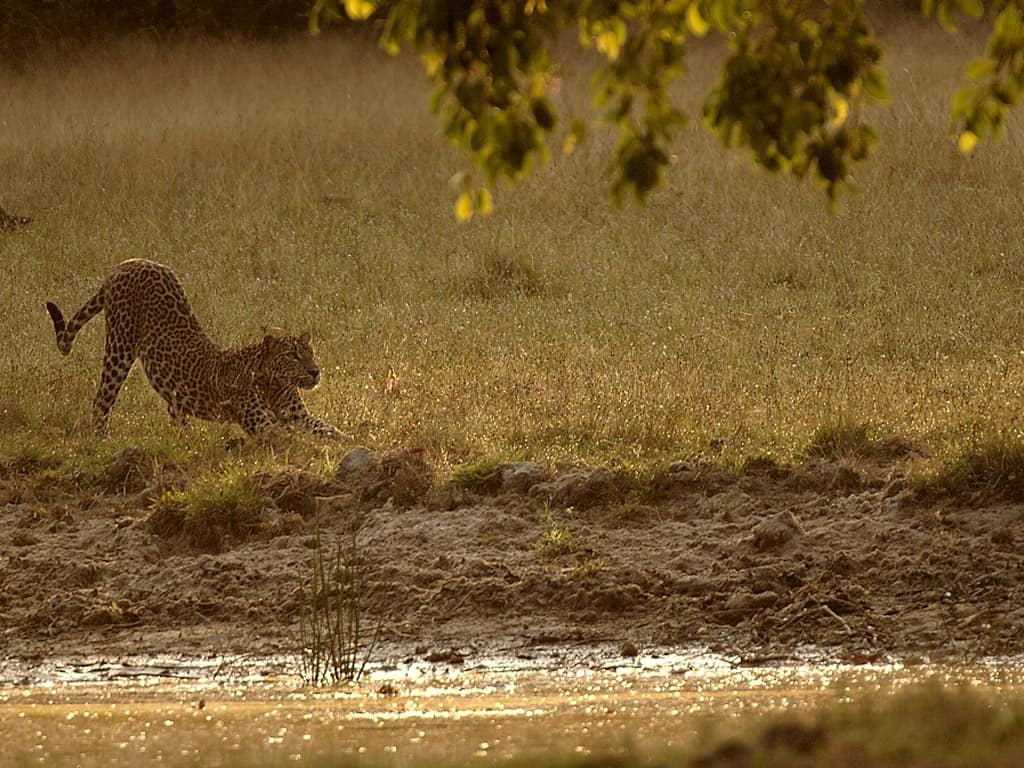
Where can I see elephants in Sri Lanka?
With roughly 7500 wild elephants found in Sri Lanka, you have some of the best opportunities to see these magnificent creatures in the whole of Asia.
- Udawalawe National Park is teeming with all kinds of wildlife but is particularly famous for its herds of Asian elephants. With fantastic viewing all year round, you would be unlucky not to see an elephant within the first 5 minutes of your safari! There is also a tremendous elephant orphanage attached to the park. Run by the Born Free Foundation, The Elephant Transit Camp helps rehabilitate injured and orphaned elephants up to 5 years old. You can learn about their work and watch them being bottle-fed three times a day. We do not support any other elephant orphanage or elephant riding on animal welfare grounds. For further reading, please check out our blog on our decision to stop promoting Pinnawella Elephant Orphanage.
- Gal Oya National Park is another one of the best places to see elephants. Arguably one of the most beautiful parts of Sri Lanka, the park itself is a dense forest with a river carving through its middle. This is the only place in Sri Lanka you can do a boat safari, and if you are lucky, you can see elephants swimming between the many islands of the park.
- Minneriya National Park and Kudulla National Park are neighbouring parks found in the Cultural Triangle and are some of Sri Lanka’s most popular parks to see elephants. Whilst you can spot elephants all year round, in the dry season (June-September) elephants from all over the region congregate in these parks due to the water sources there. Known simply as “the Gathering”, this is the largest gathering of Asian elephants in the world. This phenomenon does bring crowds though, so will not be everyone’s cup of tea.
- Wasgamua National Park is also very well known for elephants. The elephants are larger than those in Minneriya, and as the park is visited less, they tend to be “wilder”. This means that when you spot them, you really can have a pretty special experience. The best way to visit is to camp in Wasgamua for 1-2 nights – ask us for more information.
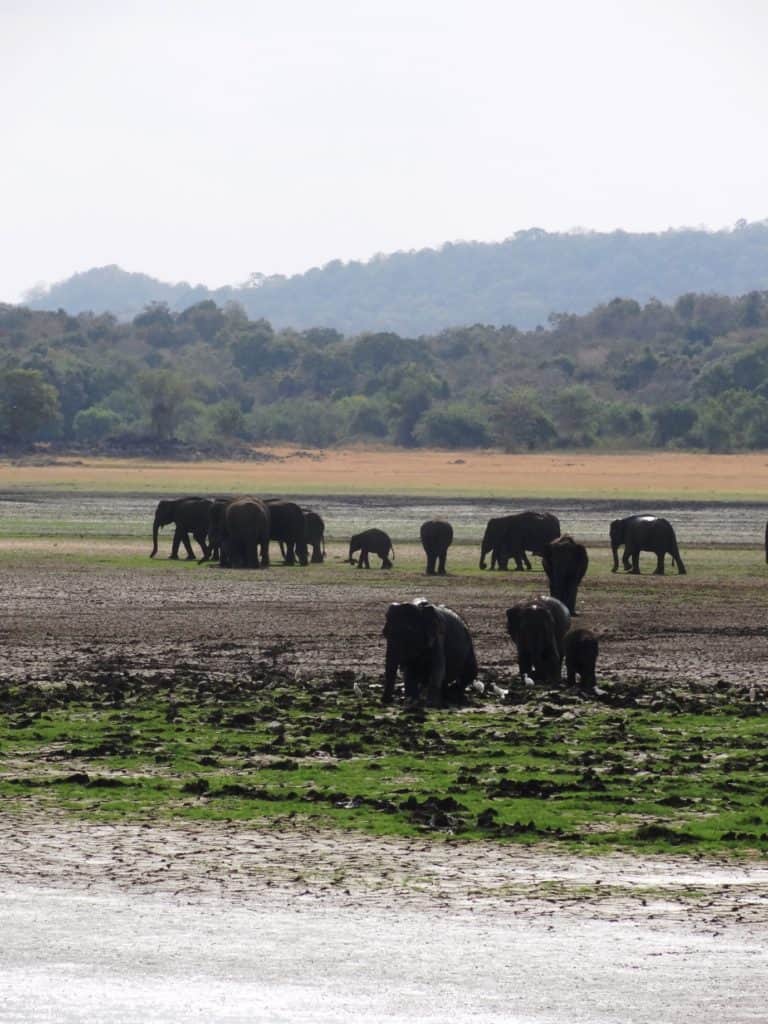
Where is best for birdwatching in Sri Lanka?
In short, anywhere! Sri Lanka has incredible birdlife all over the country. You don’t even need to be in a park to see them; you can spot birds of prey and stunning endemic birds such as the Sri Lanka Blue Magpie, Red-faced Malkoha & Sri Lanka Drongo, whilst simply driving from one place to the next. For true twitchers, however, there are some incredible spots we would recommend. Here is an example of what a birdwatching itinerary in Sri Lanka may look like.
- Sinharaja Rainforest is Sri Lanka’s last major undisturbed area of tropical rainforest and home to many birds endemic to Sri Lanka. Out of Sri Lanka’s 33 endemic bird species, all 20 rainforest species can be found in Sinharaja, making it a must-see for bird lovers.
- Bundala National Park is an integral part of a birdwatching tour of Sri Lanka due to its abundance and variety of rare and wonderful birds. Located near Yala and the beaches of the south, Bundala is a maze of waterways, lagoons, and dunes, providing the perfect home to thousands of birds. It is possible to see flocks of over 1000 Geater Flamingos.
- Kalmetiya Bird Sanctuary is a lovely destination for twitchers, also on the south coast, with over 150 species calling it their home. The land is a rich wetland made up of salty lagoons and mangrove swamps, providing shelter for a vast array of both endemic and migratory bird species. It is particularly well known for water birds.
- Horton’s Plains National Park is a mountain plateau rich in biodiversity and endemic species. Twenty-one endemic bird species live here, including the Sri Lankan blue magpie.
Where can I see sloth bears in Sri Lanka?
Sloth bears are one of the endangered animals in Sri Lanka. They are notoriously hard to spot throughout Asia and are increasingly vulnerable due to the loss of natural habitat. Situated northwest of the Cultural Triangle, Wilpattu National Park would offer you the best chances of seeing these elusive creatures, followed by Yala National Park then Wasgamua. The best time to attempt a sloth bear sighting is after the rains, I.e. April onwards. May is the absolute peak because it is the season for Palu, a fruit that sloth bears absolutely love.
Where can I see turtles in Sri Lanka?
Five out of seven types of turtles can regularly be found of the coast of Sri Lanka: Hawksbill, Green, Loggerhead, Olive Ridley and Leatherback. You can spot them all year round but the hatching season is November to March.
Turtle watching is possible on Rekewa Beach, near Tangalle on Sri Lanka’s southeast coast. We do not promote this experience as it is often deemed too intrusive for the animals, and can disturb the animals whilst they lay their eggs.
You can visit turtle hatcheries throughout the southwest coast of Sri Lanka, and you will be able to see baby turtles and injured turtles being rehabilitated. We would recommend Kosgoda as the best Turtle hatchery to visit. It takes good care of the animals and offers insightful information about turtle conservation.
Which is the best National Park in Sri Lanka?
We are often asked, “Which national park should I visit in Sri Lanka?”. In short, each park is fantastic for different reasons, so often our recommendations about which park you should visit will depend on the experience and animals you would like to see.
So, a better place to start is by considering what questions should you ask yourself when choosing which national park to visit in Sri Lanka.
How long should I stay in each National Park?
For the more accessible parks like Yala, Udawalawe and Wilpattu, two nights tend to be the norm. That said, real wildlife enthusiasts could easily stay three, particularly in Yala. Most luxury eco-lodges near Yala are ‘destination hotels’ and close to the beach too, so staying four or five nights is great for a relaxed and varied stay.
We would recommend you stay 3 nights in Gal Oya where possible to make the most of the park, the lake, nature walks, as well as the local cultural experiences available. However, it’s a stunning and tranquil place to relax, so you could easily stay longer – in this revitalise itinerary for example, we include five nights in Gal Oya Lodge.
Smaller parks such as Minneriya, Bundala & Kalametiya (both for birding) and Kaudulla can be afternoon’s excursions from wherever you are staying unless you have specific wildlife interests (in which case, we can talk about appropriate options for you).
How busy are national parks in Sri Lanka?
The answer to this can very much vary from park to park. In general, more accessible parks will be busier than the more remote parks.
As a result of its incredible natural beauty and plentiful wildlife, Yala can get very busy during the peak months, and you will likely share your viewing time with numerous other jeeps. So, is Yala National Park worth visiting? Yes, it absolutely is! Most of the crowds occur in the main entrance of Block 1, so if you choose a camping safari or luxury eco-lodge that accesses the park from a quieter entrance or explores another Block (such as Block 5), you can have a much quieter experience, that feels as wild as any in Sri Lanka – ask us for help when it comes to this. Yala really is stunning and offers a really incredible variety of animals, birds and landscapes. If the chance of spotting leopards in a wilder and less visited setting sounds better to you, we would recommend trying Wilpattu National Park on the northwest coast of Sri Lanka.
Minneriya and Kaudulla National Parks will be a busier experience as well, particularly in August and September around the gathering. They are small parks, but easily accessible as a day trip from the Cultural Triangle. The sheer number of elephants is very impressive, but for those looking for a more intimate elephant experience, why not head to Gal Oya National Park or Lahungala National Park? Do note that accommodation options are limited in these two parks, particularly Gal Oya.
Some larger parks, such as Wilpattu and Udawalawe, will generally be quieter than Yala, but will still see a steady stream of visitors in peak season. However, they are very accessible and offer a great variety of wildlife, so well worth a visit. We would recommend getting up early to be the first in the park if you are hoping to avoid other jeeps.
More remote parks such as Gal Oya, Wasgamuwa, and Kumana National Parks will offer a much quieter experience. These parks are a little further off the beaten track to get to but are worth the effort once you are there.
Are Jeep safaris the only option in Sri Lanka?
Whilst jeep safaris in Sri Lanka are most common, boat and walking safaris are also possible.
Most safaris are done in traditional safari jeeps, with raised seating and open sides to allow for the best possible animal spotting (though these will always have a roof for some shade). Alongside you and your guide will be a tracker, who knows the land and animals well. We organise our jeep safaris on a private basis, but you can book joint experiences via hotels as well.
Campsites usually offer bushwalks in the buffer zone for those interested, especially during quieter times of the year. Places like Kumana National Park have an added dimension of archaeological sites to explore on foot as well.
Ahas Pokuna Bush Camp in Sri Lanka’s hill country offers clients the opportunity to discover their surroundings on foot. These bushwalks explore the wild grasslands, waterfalls, and jungles around Ahas Pokuna. Whilst leopards, elephants and sloth bears live in this area, Ahas Pokuna is mainly known for its endemic birdlife and smaller mammals such as monkeys and deer. Your guide and tracker will be able to tailor these walks to your fitness level and interests.
Those looking to explore by boat should try Gal Oya National Park. You will cross the reservoir by boat to discover many islands that are home to birdlife, monitor lizards and elephants. If you are lucky, you may spot one swimming alongside your boat! Gal Oya Lodge is a wonderful place to stay here, with some of the best nature guides in Sri Lanka.
For the best wildlife experiences in Sri Lanka, we fully recommend mixing jeep, boat and walking safaris for sheer variety and opportunities.
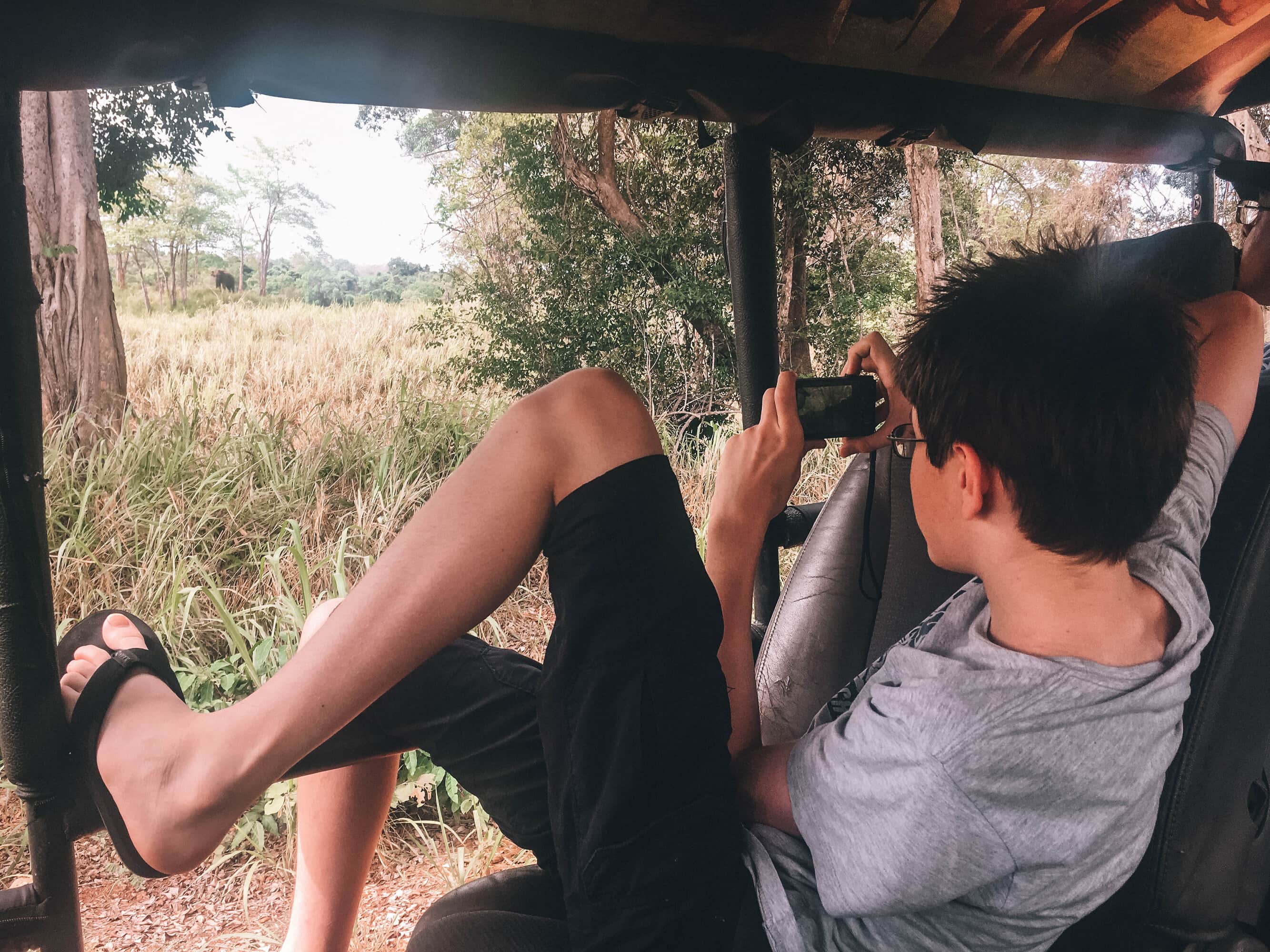
Should I stay in a hotel, lodge or tented camp?
Accommodation options vary from park to park, but most parks offer both hotel and camping stays – your accommodation choices are crucial in determining your overall wildlife experience.
Tented camps are usually situated around the edges of the national parks, in beautiful natural settings – you’ll feel right in the thick of it! For those looking to immerse in nature, this is a perfect choice. The more luxurious tented camps will often have an array of excursions (alongside your safaris), including cooking classes, bushwalks, bird watching and more, whilst basic camps will be more like a base from which to explore. The luxury camps can come at a higher price, but with all food, drink, and experiences included, they are a great value experience.
Hotels are usually located by the park entrances and offer a great experience for those who like a certain comfort level after their safaris. Unlike tented camps, the hotels will often have pools, spas, AC and sometimes multiple dining options. What you lack in adventure, you make up for in comfort!
If you’re visiting a couple of national parks, it might be worth mixing up your accommodation to get the best of both worlds.
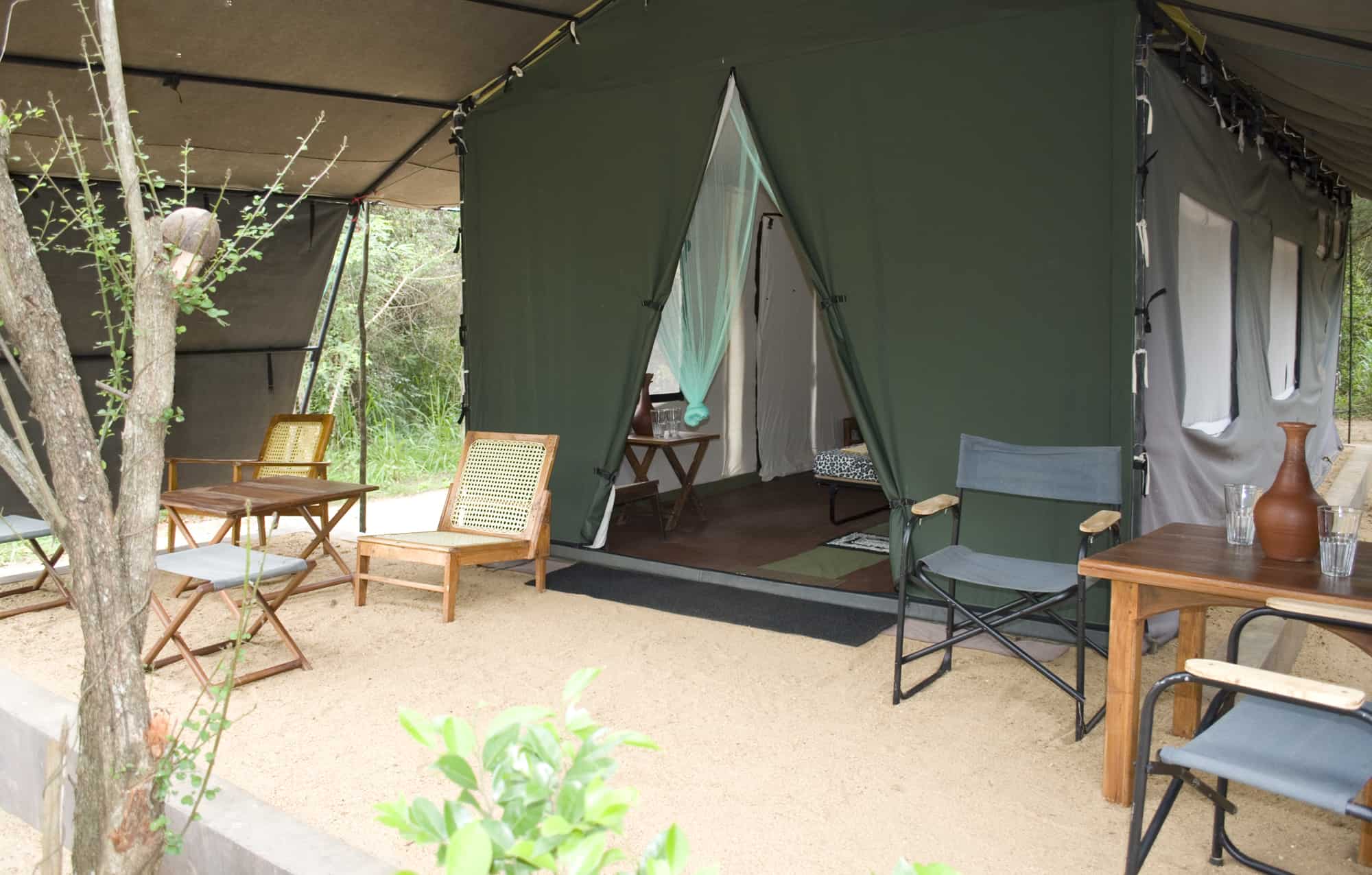
Which is better, Yala or Udawalawe?
As the two most popular National parks in Sri Lanka, we get asked to compare Yala and Udawalawe a lot. There really is no correct answer, as it depends on your priorities. They are both easily accessible, with plenty of accommodation options and excellent wildlife opportunities.
Yala has fantastic leopard spotting and many other animals including elephants, crocodiles, and birds. However, parts of it can get very crowded, which spoils the experience for some travellers.
Udawalawe is brilliant for elephants and birdlife but has lower chances of seeing leopards. It will be a quieter experience than at Yala.
For those looking for something less busy, I would recommend Udawalwe, but for those wanting the best chance of leopard spotting, then Yala would be best.
How should I include a national park in a holiday to Sri Lanka?
The National Parks are spread out all over the country, so it is very easy to include 1-2 in any trip around Sri Lanka. For example, if you are looking for a wildlife and beach holiday in Sri Lanka we would recommend focussing at least some of the trip in the south of the country, as Yala and Uda Wallawe are close to the southern beaches.
The more remote parks like Gal Oya, Wasgamua and Kumana National Parks can also work really well in a tour of Sri Lanka, particularly combined with culture in the centre of the island. You can link these parks with the East coast beaches of Passikuda and Arugam Bay. Kumana and Gal Oya can link with the south coast too, with a bit of driving. Take a look at our Into the Wild revitalise holiday to see how Gal Oya can be linked to the south coast.
Minneriya is easily linked with the Cultural Triangle too, followed by Kandy or the tea and hill country.
Wilpattu National Park is easy to combine Trincomalee and Jaffna at the beginning or end of your trip and also with the cultural triangle.
For birders, focussing on areas around the south coast pre- or post-time in Sinharaja Forest Reserve, Bundala National Park, Kalamatiya and Horton Plains is a great option as the stunning coastline is so close. The Hill Country links well with Sinharaja too.
Sri Lanka safari Vs African safari: A comparison
First off, both are fantastic – but in different ways. Africa is home to the iconic ‘Big 5’ – lion, leopard, rhinoceros, elephant, and Cape buffalo – which is tough to beat. However, Sri Lanka does have a top 5 of its own: Asian elephant, Sri Lankan leopard, sloth bear and blue and sperm whale.
Broadly speaking, Sri Lanka doesn’t have the diversity of species that many African destinations offer – although this is the same for most places outside of Africa! Only Yala National Park in Sri Lanka offers a real chance to see elephants, leopards and sloth bears (three of its big five), whereas in Africa, there are numerous national parks where you can see all of the African big five.
National parks in Africa are often huge swathes of open land with herds of different species, and wildlife sightings all but guaranteed. By contrast, national parks in Sri Lanka tend not to have such expanses or big herds: they’re often dominated by forests and tree lines, watering holes and outcrops, and are much smaller than their African counterparts. Apart from the gathering in Minneriya, sights tend to be of singular animals or in small groups as opposed to migrating herds.
The wildlife experience in Sri Lanka tends to more about the chase and anticipation as you follow the calls and signals of the wildlife, which makes it incredibly exciting (like with safaris in India).
In terms of accommodation options around or in national parks, both Africa and Sri Lanka have great diversity in quality and price levels and types of accommodation – hotels, camps, lodges etc – though for the truly high end, luxuriant options, Africa is the winner. Think safari sun-downers, sunrise hot air balloon rides, night game drives, and watering holes in front of lodges (from where you can sip a G&T as herds rush past). Sri Lanka has some great luxury options such as Wild Coast Tented Lodge, Leopard Trails and Chena Huts, but Africa beats it for those really exclusive accommodation options and experiences.
Often, African trips are dominated by safaris. In Sri Lanka, however, wildlife experiences are often part of a wider holiday, making up a few days or a week at most. With that in mind, Sri Lanka offers a combination of wildlife, culture and beaches that many African wildlife destinations can’t; a tropical island paradise with lush highlands, ancient archaeological sites and sandy beaches (plus the Maldives only a short hop away) – in addition to the amazing wildlife.
So, which is better is impossible to say; it entirely depends on what kind of experience you’re after!
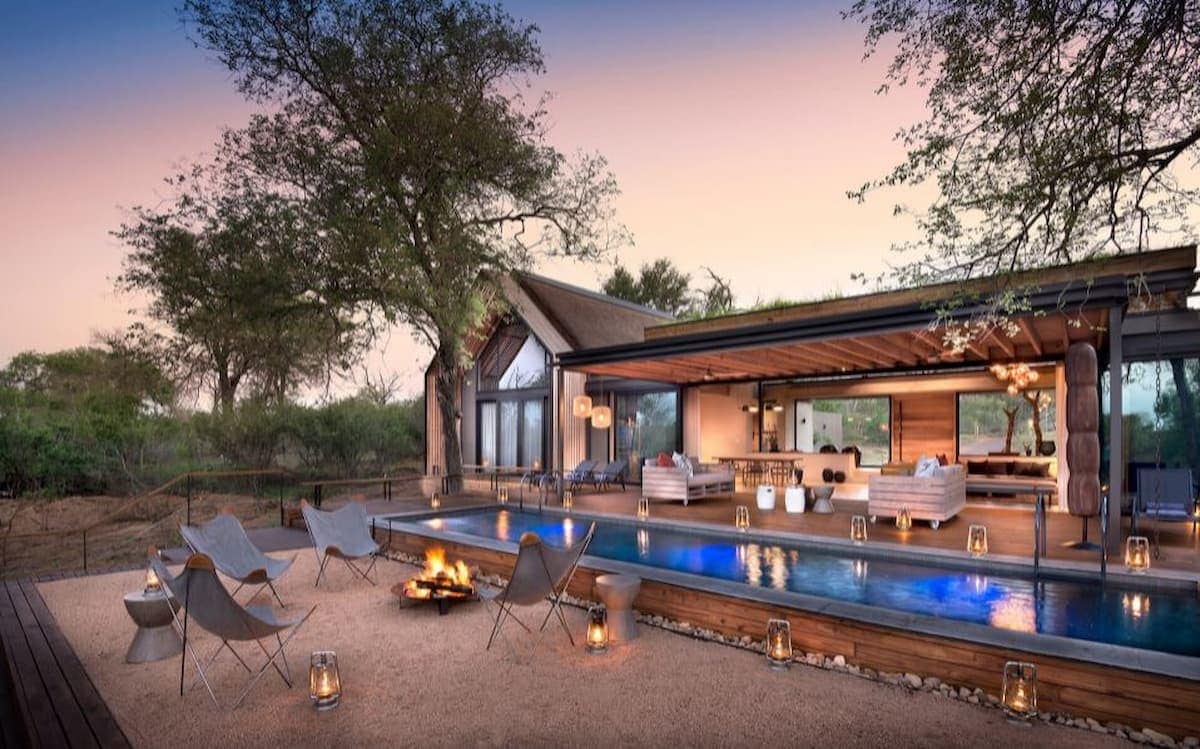
What wildlife & environmental issues are there in Sri Lanka?
Sri Lanka is a small island with a population of 21 million people, along with high densities of wildlife, which means the country faces unique challenges. One of the main challenges has been the human-elephant conflict and encroachment on endangered species habitats. Villages continually encroach on elephant populated land for Chena cultivation (slash and burn cultivation), putting themselves at risk of crossing paths with wild elephants and often resulting in elephant mortality.
In the hill country, colonists massacred elephants in thousands (Major Thomas Rogers alone killed between 1400- 1600 elephants within the span of 4 years) while setting up the tea plantations. While elephants are no longer a common sight in the hills, leopards still roam these areas. For the safety of tea pickers, the villagers have set up leopard traps all around the tea capped hills resulting in a number of leopard deaths a year.
As the country looks to develop post-pandemic, the government has declared 700,000 hectares of state forests to be removed from forest protection and utilized for agricultural purposes. This places the already precarious balance between elephants and humans in further danger. Such a move would further reduce elephant ranges (often referred to as elephant corridors) in certain areas such as Dahaiyagala, restricting them from their natural migration patterns which would essentially leave them trapped in a limited area.
With busy ship lanes falling just south of the island, they cut directly across blue whale territory. This has led to accidental whale deaths and threatens the blue whale population, especially because they are considered unorthodox whales who don’t migrate. This is further compounded by some local operators putting tourism money before the experience for travelers and the whales, but there are some great beneficial experiences too.
At the time of writing (June 2021), the country is, unfortunately, going through the biggest marine disaster in its history with unfathomable destruction to its marine ecosystem – a huge blow to the waters and local population on the west coast.
Despite such challenges, there is huge passion and appreciation for the amazing array of wildlife across the island. Spending tourism dollars in the right places is crucial and at ETG we’ll guide you through all the options available from a sustainability standpoint. We will always be upfront and honest, advising on how best to tread gently on a wildlife holiday to Sri Lanka. You can talk to Alice, our Head of Sustainability directly to discuss the options.
WANT TO LEARN MORE ABOUT THE BEST WILDLIFE EXPERIENCES IN SRI LANKA?
If you would like more Sri Lanka wildlife advice or help planning a holiday for 2021 and beyond, please don’t hesitate to get in touch.
You can make an enquiry online or give us a call on 020 7924 7133.


